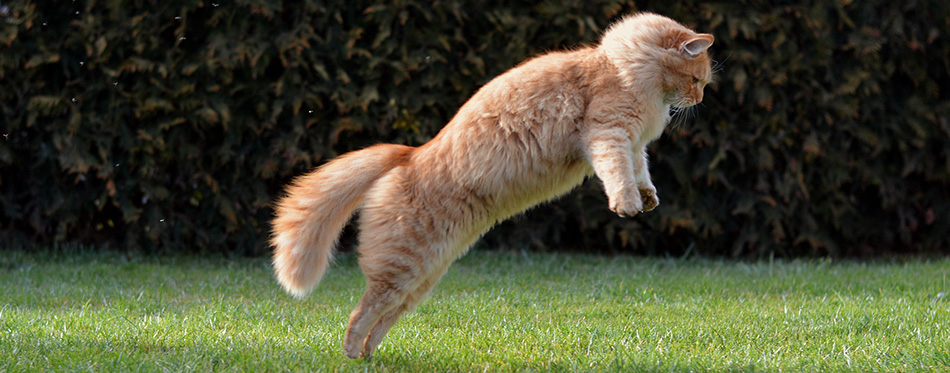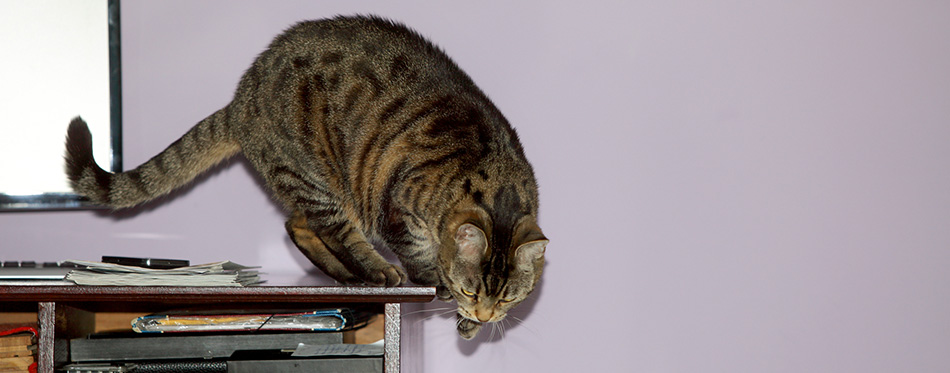It’s an old wives’ tale that everyone has heard of – ‘cats always land on their feet’ and that makes them a very lucky animal indeed! We know that cats can be incredibly agile and perhaps this is why they have nine lives! But can a cat really always land on their feet no matter how far they have fallen and how could they do this?
Read on to find out just how your kitty maintains their incredible balance as science investigates one of the best-known urban myths.

How Can Cats Land on Their Feet?
When you see your cat landing on feet and front paws with no difficulties, no matter how high they leap around your house, it is easy to see how this saying came about. We have shared our homes with felines for centuries but they have lost none of the grace and agility of their ancestors. Even when they fall off a shelf or a table backwards, they seem to be able to twist around with lightening fast speed and land the right way up! If only we humans could do the same, the emergency wards would not be so full.
How cats land on their feet has been the subject of fascinating scientific studies for some time now. It is clear that cats possess a balancing system and this has been termed the “righting reflex”. It basically flips them the right way up and allows them to get their feet underneath them before they land. However, it is also clear that the height of their fall influences their ability to land upright and safely.
Sadly, some early scientists decided to drop cats from a small height so that they could observe how they fell. They concluded that cats could somehow push off the scientist’s hands and that made them twist over. Then, in 1894, a French scientist called Etienne-Jules Marey conducted some more sophisticated experiments using a chronophotographic camera. He was able to shoot 60 frames a second as the cats fell and then view in slow-motion how they twisted to land on their feet.
Cats aren’t actually born with the righting reflex but it does develop very early on. It is seen to some extent in kittens as young as three weeks of age but is not fully developed until they are around seven weeks of age.
Cats and the Righting Reflex
The righting reflex in cats is related to their vestibular apparatus which is located inside the ear. Normally, it is used to control balance and orientation and makes sure that your cat knows what way up they are. They work out that they are upside down very quickly! Then, they rotate their head to make it the right way up and their agile body follows instantly.
So, how can cats be so agile? It starts with their skeletal structure – the cat skeleton is wonderfully unique. They have no collarbone which makes them able to twist their upper body in a way that we humans cannot. They also have an incredibly flexible spine which is made up of 30 vertebrae. These two factors work together to help a cat correct their position as they fall. The spine arches and their feet go underneath their body. At the same time, their forepaws are drawn close to their face to protect it. Cats also have a low body to weight ratio which helps to slow down their falling velocity and also helps them to land on their feet.
Do Cats Always Land on Their Feet?
Sadly, cats cannot always land on their feet and cats can and do get injured and even killed in fall accidents. The height of the fall influences whether a cat lands on their feet. A study carried out in 1987 in New York City looked at veterinary medical records of cats that had suffered a fall from a multi-story building. Despite the fact that most cats had landed on concrete, 90% of them survived their fall and only around a third needed emergency treatment.
The height of the fall was very important when it came to the outcome. Cats who had fallen from a great height (between 7 and 32 stories) suffered less injuries. Those who fell from only a small height (between two and six stories) sustained more injuries. This is not what you would expect to see. Common sense would dictate that the farther the fall, the more serious the injuries. However, the opposite is true for cats! One cat fell a staggering 32 stories, landing on concrete yet only suffered a chipped tooth and some minor lung injuries.
The explanation for this strange phenomenon is in the time that a cat has to right themselves. The more time that they have to twist, the more likely they are to land on their feet. When a cat falls, they only reach a velocity of around 60mph. Humans falling over the same distance would reach 120mph. At maximum velocity, their body relaxes and their legs stretch out. This is the same mechanism that is used by a flying squirrel. They expand their body to create air resistance and slow them down. They are a bit like a kitty parachute!

Why do Cats Always Land on Their Feet?
So, why do cats always land on their feet and how did this ability develop? It stems from the fact that wild cats spend a lot of time climbing, especially in trees. Falls were a regular occurrence and so cats had to evolve to have a way of protecting themselves. A cat’s angled and muscular legs also act like shock absorbers and absorb the impact as they land.
This is yet another reason to avoid obesity in cats because overweight cats find it almost impossible to right themselves in midair. It is also not a failsafe system and sadly some cats do die following falls. Therefore, if you live in a high-rise apartment, it is wise to keep the windows closed or to install window guards so that your cat cannot fall out.
Sources:
- WHY DO CATS ALWAYS LAND ON THEIR FEET? – Santa Clara University
- How Do Cats Always Land on All Four Feet? – Wonderopolis

